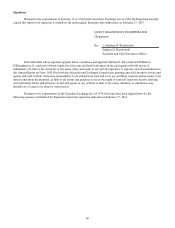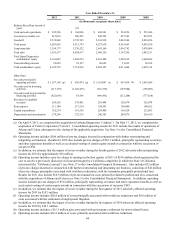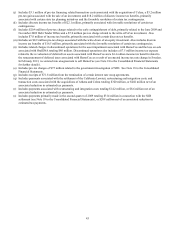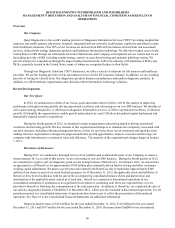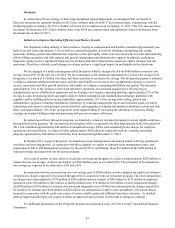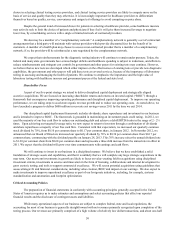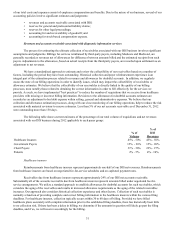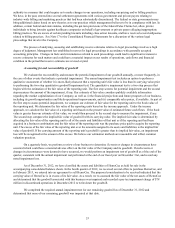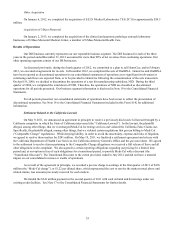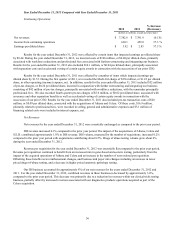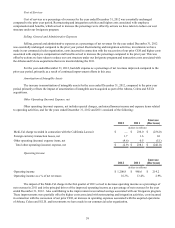Quest Diagnostics 2012 Annual Report Download - page 53
Download and view the complete annual report
Please find page 53 of the 2012 Quest Diagnostics annual report below. You can navigate through the pages in the report by either clicking on the pages listed below, or by using the keyword search tool below to find specific information within the annual report.50
choice in selecting clinical testing service providers, and clinical testing service providers are likely to compete more on the
basis of service and quality than they may otherwise. It is increasingly important for healthcare providers to differentiate
themselves based on quality, service, convenience and unique test offerings to avoid competing on price alone.
Despite the general trend of increased choice for patients in selecting a healthcare provider, some healthcare insurers
may actively seek to limit the choice of patients and physicians if they feel it will give them increased leverage to negotiate
lower fees, by consolidating services with a single or limited network of contracted providers.
We also may be a member of a “complementary network.” A complementary network is generally a set of contractual
arrangements that a third party will maintain with various providers which provide discounted fees for the benefit of its
customers. A member of a health plan may choose to access a non-contracted provider that is a member of a complementary
network; if so, the provider will be reimbursed at a rate negotiated by the complementary network.
We expect that reimbursements for the diagnostic testing industry will continue to remain under pressure. Today, the
federal and many state governments face serious budget deficits and healthcare spending is subject to reductions, and efforts to
reduce reimbursements and stringent cost controls by government and other payers for existing tests may continue. However,
we believe that as new tests are developed which either improve on the effectiveness of existing tests or provide new diagnostic
capabilities, the government and other payers will add these tests as covered services, because of the importance of laboratory
testing in assessing and managing the health of patients. We continue to emphasize the importance and the high value of
laboratory testing with healthcare insurers and government payers at the federal and state level.
Shareholder Focus
As part of our five-point strategy we intend to deliver disciplined capital deployment and strategically aligned
accretive acquisitions. We are focused on increasing shareholder returns and returns on invested capital (“ROIC”) through a
framework that encompasses improving operating performance and disciplined capital deployment. To improve our operating
performance, we are taking steps to accelerate organic revenue growth and to reduce our operating costs. As noted above, we
have launched a program to deliver $600 million in run-rate cost savings versus 2011 by the time we exit 2014.
Our disciplined capital deployment framework includes dividends, share repurchases and investment in our business
and is intended to improve ROIC. The framework is grounded in maintaining an investment grade credit rating. In 2012, we
used the majority of our free cash flow to reduce our outstanding debt and achieve a debt/EBITDA ratio in the range of 2 - 2¼
times. Upon achieving our targeted leverage ratio, we now expect to return to investors through a combination of dividends
and share repurchases a majority of our free cash flow. Consistent with that expectation, we increased our quarterly common
stock dividend by 70%, from $0.10 per common share to $0.17 per common share, in January 2012. In November 2012, we
announced that our Board of Directors increased our quarterly dividend by 76% to $0.30 per common share from $0.17 per
common share, commencing with the dividend payable on January 28, 2013. This 76% increase raises the annual dividend rate
to $1.20 per common share from $0.68 per common share and represents a three-fold increase from the annual rate in effect in
2011. We expect that the dividend will grow over time commensurate with earnings and cash flows.
We will continue to invest in our business in a disciplined manner. We believe that we have established a solid
foundation of strategic assets and capabilities, and that it is unlikely that we will complete any large strategic acquisitions in the
near term. Our near-term investments in growth are likely to focus on value-creating fold-in acquisitions using disciplined
investment criteria, investments in science and innovation in the form of licensing, collaborations and internal development to
grow esoteric testing, and tools to support commercial excellence. We will screen potential acquisitions using guidelines that
assess strategic fit and financial considerations, including value creation, ROIC and impact on our earnings. We also expect to
make investments to improve operational excellence as part of our Invigorate initiatives, including, for example, systems
standardization and automation, and footprint optimization.
Critical Accounting Policies
The preparation of financial statements in conformity with accounting principles generally accepted in the United
States of America requires us to make estimates and assumptions and select accounting policies that affect our reported
financial results and the disclosure of contingent assets and liabilities.
While many operational aspects of our business are subject to complex federal, state and local regulations, the
accounting for most of our business is generally straightforward with net revenues primarily recognized upon completion of the
testing process. Our revenues are primarily comprised of a high volume of relatively low dollar transactions, and about one-half


